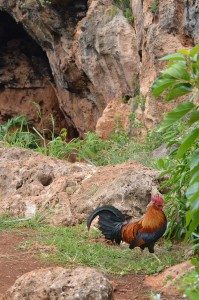The Chickens of the Canoe People
March 24, 2014
Can you think of a single island in the world (not even Key West, Florida), where there are more feral chickens around than on Kaua`i? But in the sediments of Makauwahi Cave,

A feral rooster strolls by the South Cave entrance to Makauwahi Cave. Cave sediments from the time before European arrival contain bones with ancient DNA that traces them back to Hawaiian’s native homelands in island Southeast Asia.(photo by Lida Pigott Burney)
back centuries ago before the advent of Europeans with chickens, there are plenty of fossil bones of an ancient breed — chickens that came with the first Hawaiians.
The ancient DNA recovered from these bones, and those of two other sites in the Pacific region, made international news this week as the fossil evidence in a paper published in Proceedings of the National Academy of Sciences, USA.
The study, led by the University of Adelaide’s Australian Centre for Ancient DNA (ACAD), makes a major contribution to the effort to reconstruct the early migrations of people and the animals they carried with them. The research group concluded that previous claims of contact between early Polynesians and South America from chicken DNA were probably based on contaminated results. Instead, the new study has identified and traced a unique genetic marker of the original Polynesian chickens that is only present in the Pacific and Island Southeast Asia.
“We have identified genetic signatures of the original Polynesian chickens, and used these to track early movements and trading patterns across the Pacific,” says lead author Dr Vicki Thomson of ACAD. “We were also able to trace the origins of these lineages back into the Philippines, providing clues about the source of the original Polynesian chicken populations.”
Our research team of national and international collaborators included Dr. Terry Hunt (many of our volunteers and visitors have met Terry at Makauwahi Cave during field schools in years past), as well as scientists from the Australian National University, University of Sydney, and Durham and Aberdeen Universities in the UK. The lab used female-inherited mitochondrial DNA extracted from chicken bones excavated in archaeological digs including Makauwahi Cave, as well as sites on Rapa Nui (Easter Island) and Niue.
The ancient DNA recovered from Polynesian-era chicken bones excavated in Makauwahi Cave is just one of many such opportunities offered by the remarkable preservation observed in this site. We also know from preliminary studies that the sediments preserve ancient DNA of endemic Pritchardia palms, extinct giant flightless ducks, and a host of other species. We are just beginning to tap the cave’s great potential for fossil DNA research.
The chicken DNA project leader Professor Alan Cooper, Director of ACAD says: “We were able to re-examine bones used in previous studies that had linked ancient Pacific and South American chickens, suggesting early human contact, and found that some of the results were contaminated with modern chicken DNA, which occurs at trace levels in many laboratory components. We were able to show that the ancient chicken DNA provided no evidence of any pre-Columbian contact between these areas.”
“Remarkably, our study also shows that the original Polynesian lineages appear to have survived on some isolated Pacific islands, despite the introduction of European domestic animals across the Pacific in the last couple of hundred years,” Professor Cooper says. “These original lineages could be of considerable importance to the poultry industry which is concerned about the lack of genetic diversity in commercial stocks.”
So we need to take another look at those myriad feral chickens dutifully scratching the ground at Makauwahi Cave Reserve. Studies of DNA in the modern chickens of Kaua`i has so far turned up no trace of the “Polynesian sequence,” but we need to keep looking. A living “canoe chicken” would be good to find.
Comments:
laura on April 10, 2014
FASCINATING !! Can't wait to see those "canoe chicken" for myself in August !!